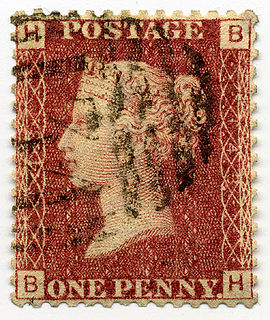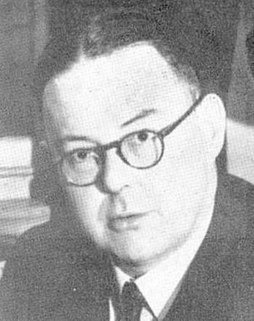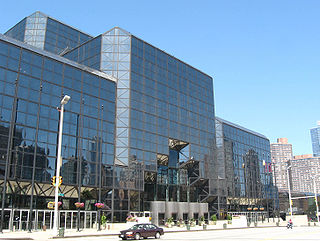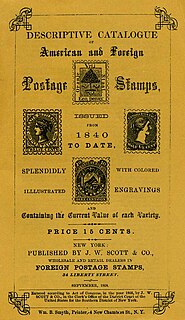
Philately is the study of stamps and postal history and other related items. It also refers to the collection, appreciation and research activities on stamps and other philatelic products. Philately involves more than just stamp collecting, which does not necessarily involve the study of stamps. It is possible to be a philatelist without owning any stamps. For instance, the stamps being studied may be very rare, or reside only in museums.

A cancellation is a postal marking applied on a postage stamp or postal stationery to deface the stamp and prevent its re-use. Cancellations come in a huge variety of designs, shapes, sizes and colors. Modern cancellations commonly include the date and post office location where the stamps were mailed, in addition to lines or bars designed to cover the stamp itself. The term "postal marking" sometimes is used to refer specifically to the part that contains the date and posting location, although the term often is used interchangeably with "cancellation." The portion of a cancellation that is designed to deface the stamp and does not contain writing is also called the "obliteration" or killer. Some stamps are issued pre-cancelled with a printed or stamped cancellation and do not need to have a cancellation added. Cancellations can affect the value of stamps to collectors, positively or negatively. The cancellations of some countries have been extensively studied by philatelists and many stamp collectors and postal history collectors collect cancellations in addition to the stamps themselves.

John Harry Robson Lowe, Robbie to his friends, was an English professional philatelist, stamp dealer and stamp auctioneer.
Harry L. Lindquist was an editor and publisher specializing in the publication of philatelic literature during the early 20th century. He operated his publishing business from New York City at 1 West 46 Street.
August Dietz was a philatelist, editor and publisher, who specialized in the study of mail and postal history of the Confederate States of America.
Winthrop Smillie Boggs was a philatelist renowned for his expertise and philatelic writing.
James Richard William Purves – generally denoted in publications as J. R. W. Purves -- was an Australian lawyer and philatelist. His half century of work in Australian philately earned him the title “The personification of Australia in International Philately.”

Henry M. Goodkind of New York City, was a distinguished American philatelist who specialized in the study of air mail postage stamps of the world, and published numerous articles and studies on the subject.
John Robert Boker Jr., of New York City, was a philatelist who amassed some of the most prestigious collections of 19th century stamps ever seen by stamp collectors. Before his death in 2003, the Collectors Club of New York declared him, in 1996, to be the "outstanding philatelist of the last half of the twentieth century."
Philip Silver (1909–1999), of New York City, was a philatelist who specialized in the field of air mail stamps, known as aerophilately. He studied air mail stamps and postal history, and wrote extensively on the subject.
Nicolas Sanabria of New York City, was a philatelist concerned primarily with the field of aerophilately. His name is familiar to philatelists because of his Sanabria Catalog.
Woodrow Wilson Hulme II was a philatelist noted for his work in advancing the appreciation of stamp collecting, especially by his work at the National Postal Museum in Washington, D.C.
Walter J. Conrath, of Pennsylvania, was a stamp collector who specialized in aerophilately, the study of air mail stamps, and wrote extensively on the subject. His career was cut short when he died in an automobile accident at the age of 35.
Victor E. Engstrom was an American philatelist known for his knowledge and collections of stamps of Nordic countries.
William Woodbury Hicks, of Pennsylvania, was a student of early postage stamps and postal history of the United States.
Lloyd B. Gatchell of New York City, was a philatelist who was named to the Hall of Fame of the American Philatelic Society. He was known as “Bart” to his philatelic friends and acquaintances.

World Stamp Show-NY 2016 was the United States' once-a-decade international celebration of stamp collecting. It took place at the Jacob K. Javits Convention Center in New York from May 28 to June 4, 2016. This was the first international stamp show to be held in New York since FIPEX in 1956.












